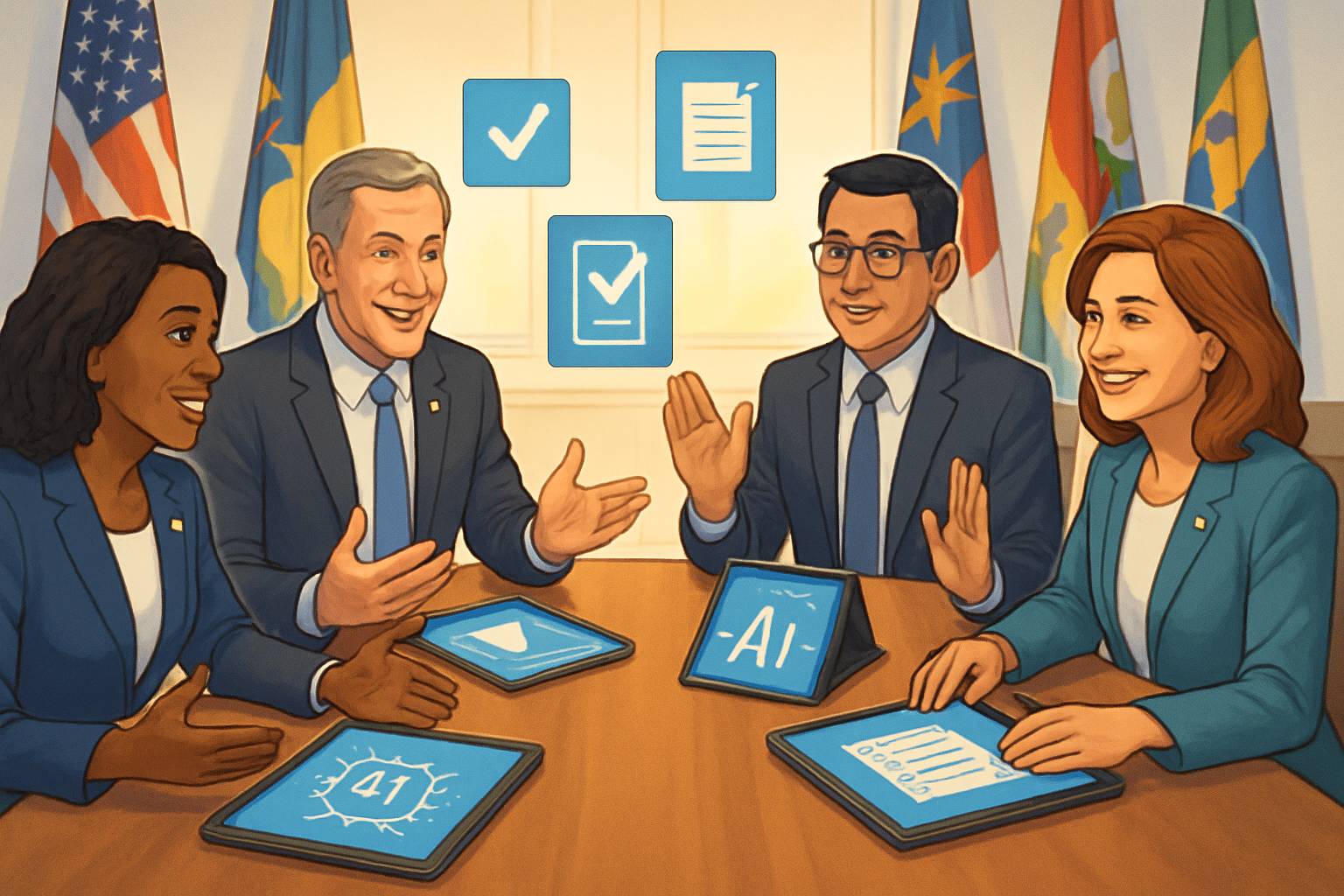
AI CERTS
5 hours ago
Interstate coordination accelerates AI policy harmonization
This article explains how the multistate working group functions and where it heads next. Along the way, we analyze benefits, risks, and future legislative scenarios. Primary sources include FPF statements, Princeton analysis, and industry letters. Therefore, professionals can track developments and plan compliance strategies. Interstate coordination remains the story’s central thread.
States Seek Policy Unity
FPF launched the Multistate AI Policymaker Working Group in 2023. Furthermore, attendance quickly surpassed 200 legislators from more than 45 states. The initiative relied on interstate coordination to exchange drafts under Chatham House Rule.

Princeton’s CITP assumed convening duties after FPF exited in February 2025. Meanwhile, Sen. James Maroney leads a steering committee that maintains momentum. Additionally, CITP convened its first State AI Policy Forum on September 25, 2025.
Participants share lessons, agree on terminology, and circulate early clauses in real time. Consequently, model legislation reached drafters before formal filing windows opened. Such early access fosters consistent approaches across diverse political environments.
The venues may shift, yet alignment efforts persist. Therefore, observers should watch membership and venue stability going forward.
How Working Groups Operate
Drafting starts with small expert circles producing annotated templates. Subsequently, lawmakers host virtual feedback sessions inviting civil society and industry. SIIA’s February 2025 letter offers one documented example.
After comments, coordinators integrate revisions and publish revised model legislation within days. Moreover, each draft references the NIST AI Risk Management Framework for technical grounding. States then localize obligations, agency powers, and effective dates.
In contrast, states acting alone often duplicate analysis and face steep learning curves. Consequently, interstate coordination trims research costs and accelerates committee hearings. Legislators report that common talking points shorten stakeholder negotiations by weeks.
Shared workflows therefore standardize process and vocabulary. However, ultimate enactment still depends on state politics, as the next section shows.
Key Provisions Taking Shape
The group’s model legislation centers on identifying high-risk systems. Therefore, any tool influencing employment, housing, credit, or benefits triggers extra duties. Obligations include algorithmic impact assessments, record keeping, and public summaries.
States also debate watermarking rules for synthetic media. Moreover, disclosure clauses require clear labels on AI generated content. Such measures support consistent approaches that empower consumers.
High-Risk Systems Defined
Colorado’s AI Act provides a reference case. The statute mandates impact assessments before deployment and annually thereafter. Consequently, enterprises must map data sources, performance metrics, and mitigation plans.
Other states imported identical text through interstate coordination channels. Utah, Virginia, and Texas introduced near-verbatim sections in 2025 sessions. Finally, many drafts incorporate voluntary NIST controls, promoting harmonization efforts across jurisdictions.
Key clauses now travel faster than ever. Therefore, compliance leaders should monitor multistate bulletins for emerging tweaks.
Benefits For Lawmakers Industry
Supporters cite three primary gains from the 45-state collaboration. First, shared drafting reduces staff workload and analytical costs. Second, consistent approaches minimize conflicting compliance demands for nationwide companies.
Third, harmonization efforts create predictable risk disclosure expectations for consumers. Moreover, lawmakers from smaller states gain access to expert testimony they may otherwise lack. Consequently, bills arrive stronger and face fewer late-stage overhauls.
- Over 1,100 AI bills filed during 2025 sessions
- 62 lawmakers from 32 states backed a pro-coordination op-ed
- Colorado enacted SB-205 within 18 months of template release
Additionally, professionals can boost expertise through the AI Policy Maker™ certification. The course covers risk assessments, stakeholder engagement, and legislative drafting mechanics. Consequently, graduates speak the same language as working group leaders. Robust interstate coordination also deepens shared vocabulary among staff attorneys.
The collaboration therefore saves time and strengthens protections. However, not everyone applauds the strategy, as the next section explores.
Political Frictions And Risks
FPF’s withdrawal revealed potential reputational hazards for civil society conveners. In contrast, critics accused the group of importing European-style regulation. Nevertheless, FPF denied that intention and published a clarifying statement.
Industry voices warn about patchwork obligations despite harmonization efforts. Additionally, inconsistent high-risk definitions could impede innovation and investment. Therefore, several trade groups push for optional safe harbors aligned with NIST.
Legislators also debate federal preemption versus state autonomy. Consequently, some observers predict congressional action if 50 distinct laws emerge. Meanwhile, others argue experimentation drives better eventual national standards.
Political pressures thus remain significant and unpredictable. Nevertheless, interstate coordination continues, setting the stage for future negotiation.
Future Moves To Watch
CITP plans additional forums and may release updated templates in 2026. Moreover, lawmakers expect another surge of bills when sessions open in January. Observers should track which clauses from existing model legislation survive intact.
Numbers suggest activity will stay intense. Successful interstate coordination will determine how quickly enterprises gain clarity. The laweconcenter tallied 1,100 AI bills this year alone. Consequently, companies need monitoring tools that flag overlaps and deviations.
Additionally, harmonization efforts may shift toward formal interstate compacts if federal action stalls. In contrast, rapid federal preemption could render many state experiments moot. Therefore, strategic positioning requires agility and informed advocacy.
Timelines look compressed and outcomes remain fluid. Consequently, staying engaged with interstate coordination forums delivers early visibility.
Conclusion And Next Steps
Multistate AI policymaking has matured from ad-hoc calls into structured, bipartisan machinery. Interstate coordination now links 45-state collaboration, consistent approaches, and harmonization efforts.
However, political headwinds and technical complexity still threaten unified outcomes. Nevertheless, pragmatic engagement offers the best path toward balanced guardrails. Therefore, professionals should follow working group calendars, comment periods, and bill trackers. Finally, the AI Policy Maker™ certification equips professionals for evolving obligations.
Engage now and shape tomorrow’s standards. Click the link, join discussions, and lead responsibly.



